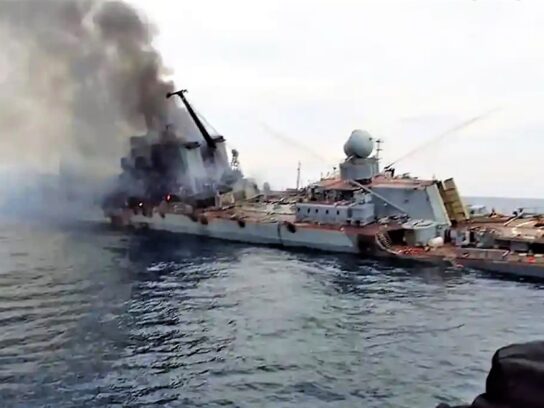
I predicted in this column back in mid-January, before the invasion of Ukraine, that Putin would invade and would focus on seizing the Black Sea coast, in order to strangle the country’s economy and people. That is now happening. Of course I support Ukraine, and still someday want to visit the best man at my wedding, who lives in Kiev with his family. (He reports that his family is OK despite distant explosions, and have sufficient food and supplies.)
The most startling recent event in this deadly struggle was the April 14 sinking of the Russian Black Sea flagship, the cruiser Moskva. How did that happen, who sank it, and what should that mean for future strategy and tactics? Let’s find out.
Moskva was was one of the most heavily defended assets in the Russian Navy. One naval analyst previously thought of it as “invincible” against air attack. The ship was designed to use its 16 large, offensive supersonic P-1000 Vulkan anti-ship missiles to punch a huge hole in a US Nimitz-class carrier group. Its defensive weapons were also quite impressive, consisting of 64 highly capable S-300F vertically-launched “Fort”anti-aircraft missiles, with an effective anti-missile range of over ten nautical miles (NM) (about 11 statute miles); 40 Osa-M short range (5 NM) “Wasp” anti-missile missiles; and 6 AK-630 30 millimeter six-barrelled Gatling guns, firing 4500 rounds per minute, with an anti-missile range of 2 NM.
This substantial triple-layer defense should have been capable of defeating dozens or even scores of incoming anti-ship missiles. But it is pretty clear that just two Ukrainian-built Neptune missiles, each traveling at a rather pokey sub-sonic speed of 650 mph, using detectable and jam-able radar homing, and with only a 330-pound warhead, managed to defeat all those defenses.
There are indications that the Moskva was also threatened by several Turkish-made, Ukrainian Bayraktar TB2 attack drones which spotted, tracked and perhaps distracted the vessel. But the The Russian cruiser had sophisticated, 360-degree, dual-system surveillance radars, which could quickly hand off to its numerous target-tracking radars, linked to automatic fire-control systems. Distraction should not have happened.
So what went wrong? Why is the Moskva just the latest dive destination in the Black Sea? At least six things are very likely:
First, over-centralization of command authority. The Russian/Soviet approach gives the “big man” total control; subordinates usually are not delegated authority to take action, unlike in the US and Royal Navy. Successful anti-missile defense is very complex and highly dependent on human factors; over-centralization can waste seconds. Seconds matter.
Second, lack of a good NCO corps. In a modern army or navy, the non-commissioned officers have decades of experience, and they execute the strategy developed by the officers. The Russians lack good NCOs at sea and on land.
Third, lack of training and maintenance. Training on and maintenance of equipment is expensive and tiring, but essential. The Russians do not focus on this, rather on producing lots of equipment units.
Fourth, complacency based on poor intelligence. The Russians apparently had intel that the latest Neptune missiles were not in service and thus had not been used in the first month of the war. So the ship was loitering just 30 NM off the Ukrainian coast, making it more vulnerable.
Fifth, poor damage control. In the US and UK navies, every sailor is taught and regularly trains in damage control and firefighting. Any Western vessel, from a destroyer escort up to a carrier, which was hit by two Neptunes would almost certainly survive and remain in the fight, due to rapid, effective damage control. The Russians only train a small fraction of their crews in these vital skills.
Sixth, poor ship design. The Moskva has several design flaws, including having all its 16 major offensive missiles exposed on deck, and having its AK-630 close-in weapon system (CIWS) with a long loading belt leading deep into the belly of the ship. One credible theory is that one of the AK-630 turrets was hit by a Neptune, and secondary explosions went off all the way down the loading belt, into the CIWS magazine. (The US Phalanx CIWS has all its ammunition in the gun mount, so secondary explosions will not damage the ship’s interior.)
What all this means for future strategy and tactics is that NATO and the Ukrainians need to stop thinking of Russian ships as intimidating enemy assets. Rather they are more like big fat sitting ducks – targets for morale-, prestige- and budget-crushing blows. (Replacing the Moskva will cost over $750 million USD and take 5+ years.) There are two other Slava-class Russian cruisers similar to Moskva in the eastern Med and Aegean, protecting the entrance to the Dardanelles from NATO warships, with about 14 accompanying vessels.
How can they be attacked, since Ukraine’s navy now consists of only a few patrol boats, a minesweeper and a spy ship? NATO needs to take a leaf from the history books of WW I and WW II. The US has already frozen over $100 Billion USD in Russian funds held by US banks. Take a paltry $100 million of that (one tenth of one percent), give it to the Ukrainians, and have them spend it on buying and arming “Q-ships.” These would be merchant vessels with hidden armaments, such as many more Neptunes. That will take some months, but I predict that this war will last at least until April of 2023, through the dry season of this summer (currently the southeast of Ukraine is a sea of mud) and the good fighting season of December to early March (when tanks can easily maneuver across the frozen terrain).
Our original question was, “Who sank the Moskva?” I would argue that while the Ukrainians helped, the real answer is: the Russians sank the Moskva, because of who they are.
Photos courtesy Lew Toulmin
- Map in the upper left shows the area of operations, with Moskva only 30 nautical miles off the coast of Ukraine, in the Black Sea, south of the key Ukrainian port of Odesa and northwest of the Russian-controlled port of Sevastapol. The main image shows satellite radar picking up the Moskva (the greenish/yellow blob) after being struck by missiles, with about three rescue and support vessels close by, and three other distant vessels.
- The Russian cruiser Moskva, flagship of the Black Sea fleet, on fire and listing heavily to port. The stern is on the right with the helicopter landing pad and the helicopter hanger doors are open. The bow is on the far left, concealed in smoke. Note the calm sea state and light winds, shown by the smoke going almost straight up in a column.
- Analysis of the damage shows that possibly a close-in weapons system (CIWS) magazine and a main damage control and electricity control center was hit.
- Comparison of the side of the Moskva before (right) and after (left) the ship was hit shows that all the lifeboats have been deployed. It is estimated by Western analysts that between 250 and 400 of the ship’s crew of 510 were killed; while the Russians claim no-one was killed.
- Statistics on the Moskva cruiser and the Ukrainian-made missile that sank it. The Moskva will cost over $750 million USD and take five years to replace. The Neptune, by contrast, probably costs about the same or less than the $500,000 per unit cost of the similar Russian Kh-35 anti-ship missile, and can be produced in weeks or months. So the Ukrainians spent about $1 million to destroy $750 million. That’s the way to win a war.
- The AK-630 CIWS Gatling gun is the very effective, last ditch, close-in defensive weapon against missile attack. But six of these, and two other major, well-regarded systems failed to protect the Moskva. The broad white arrows point to the location of the CIWS turrets; in the upper right is an image of the CIWS in action.
- The map on the left shows that the swells in the northwest Black Sea on the day of the attack were less than one meter high. The map on the right shows that winds were light in that area, as indicated by the arrows with only one tail. By contrast, the Russian Navy spokesmen claimed that the Moskva had an ammunition fire, was not struck by missiles, and was under tow in a storm with “very heavy seas” when she sank. Question: How do you know when a Russian official is lying? Answer: When his lips are moving.
- This immediately famous Ukrainian postage stamp shows a single Ukrainian Army soldier “giving the finger” to the captain of the Moskva as he demands surrender of Snake Island, early in the war. Reportedly the soldier yelled out “Russian warship — Go f**k yourself!” Later the Ukrainian soldiers on the island were captured, but were exchanged and survived.
- A cartoon of the Moskva being sunk by a Ukrainian tractor, labeled as “The true story of what actually happened.” Ukrainian farmers’ tractors have become famous during the war, as a “secret weapon” that comes out after a battle and tows away damaged Russian tanks and vehicles, then takes them to repair shops to be fixed up for the Ukrainian Army.













Comments are closed.